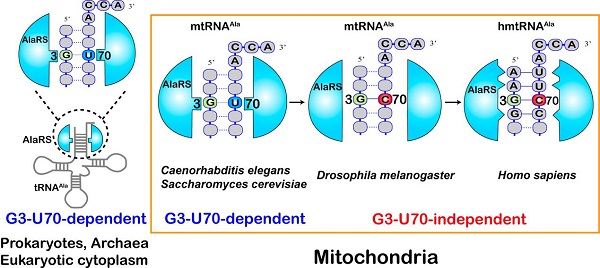Researchers identified the G3-U70-independent tRNA recognition by human mitochondrial alanyl-tRNA synthetase
Source:
Time: 2019-02-22
On 15 Feb.《Nucleic Acids Research》online published a new work from Prof. En-Duo Wang’s group in the Institute of Biochemistry and Cell Biology entitled “The G3-U70-independent tRNA recognition by human mitochondrial alanyl-tRNA synthetase”.
Alanyl-tRNA synthetase (AlaRS) is to generate Ala-tRNAAla for protein biosynthesis. AlaRSs from bacteria, archaea and eukaryotic cytoplasm predominantly rely on a single wobble base pair, G3-U70, of tRNAAla as a major determinant, recognized by specific motifs. Minor decrease in the editing function of mouse cytoplasmic AlaRS leads to neurodegeneration. Our previous work has shown that editing function of human mitochondrial AlaRS (hmtAlaRS) is crucial for embryonic development (Nucleic Acids Res., 2018). Further, mutations on hmtAlaRS gene (AARS2) lead to the severe infantile-onset cardiomyopathy, including R592W identified by others and our recently identified R580W (Hum Mol Genet., 2019). However, how human mitochondrial tRNAAla (hmtRNAAla) is recognized by hmtAlaRS remains unclear.
Under the supervision of Professors En-Duo Wang and Xiao-Long Zhou, Ph. D candidates Qi-Yu Zeng et al. showed that hmtAlaRS is a monomer and recognizes mitochondrial tRNAAla in a G3-U70-independent manner, requiring several elements in the acceptor stem, which is different from the G3-U70-dependent recognition of mitochondrial tRNAAla by mitochondrial AlaRSs from C. elegans and S. cerevisiae but has both similarity and difference with that by mitochondrial AlaRS from D. melanogaster. In addition, hmtAlaRS misactivated noncognate Gly and catalyzed strong tRNA-independent pre-transfer editing for Gly besides post-transfer editing; a crucial residue for the tRNA translocation from aminoacylation into the editing domain during editing has been identified. Finally, the effects of the severe infantile-onset cardiomyopathy-associated R592W mutation of hmtAlaRS on the canonical enzymatic activities of hmtAlaRS were investigated.
Overall, this work provides fundamental information about tRNA recognition and deepens our understanding of translational quality control mechanisms by hmtAlaRS.
This work was supported by grants from the National Key Research and Development Program of China; National Natural Science Foundation of China; Strategic Priority Research Program of the Chinese Academy of Sciences; Youth Innovation Promotion Association, CAS; and Shanghai Rising-Star Program.

The G3-U70-independent tRNA recognition by human mitochondrial AlaRS and its co-evolution with mitochondrial tRNAAla

 Appendix:
Appendix: